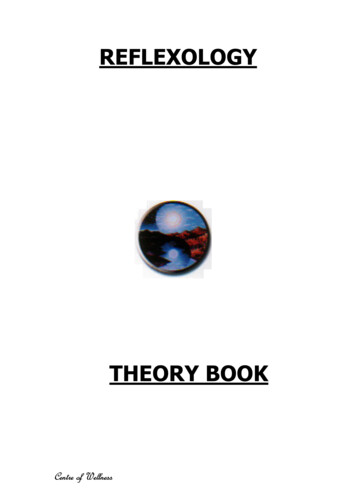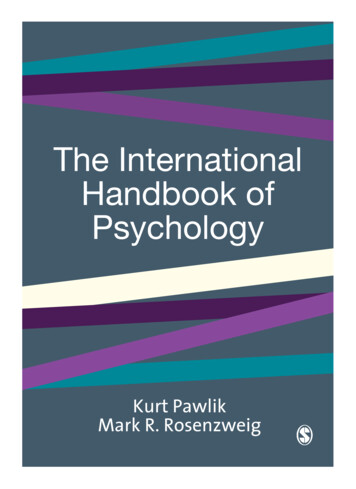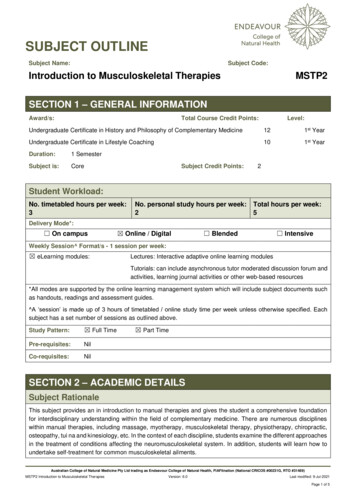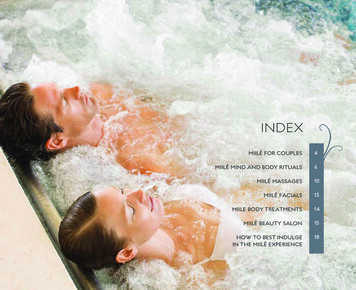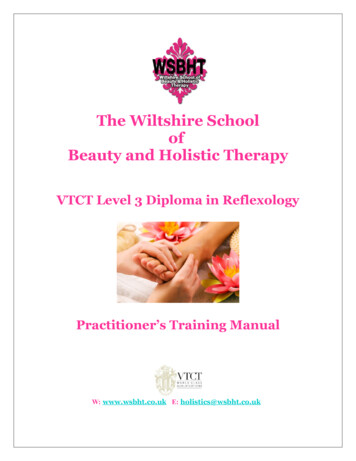
Transcription
The Wiltshire SchoolofBeauty and Holistic TherapyVTCT Level 3 Diploma in ReflexologyPractitioner’s Training ManualW: www.wsbht.co.uk E: holistics@wsbht.co.uk
T: 01793 73 77 33 M: 07824 337333The Wiltshire School of Beauty and Holistic TherapyDiploma in Reflexology Training Manual 2
CONTENTS1.Aims & Objectivesp32.Course Detailp43.Reflexology Introductionp54.Hygiene, Health & Safetyp95.Ethics & Standards of Practicep146.Principles and Practices of Complementary Therapiesp177.Anatomy, Physiology and Pathologiesp328.Client Actionsp11711.Aftercarep11812.Equipment & Productsp11913.Storage & Insurancep12014.Mapping of Reflex Pointsp12115.Reflexology Routinep12416.Business Practice for Complementary Therapiesp12717.What Happens Next?p14218. Contact Details & Recommended Readingp14319. Self Assessmentp14420. Notesp14621. Accreditationp147The Wiltshire School of Beauty and Holistic TherapyDiploma in Reflexology Training Manual 3
1. AIMS & OBJECTIVESAIMSThe aim of this manual is to teach the student the basics of health and safety, andanatomy and physiology in relation to this course. This manual also covers thebackground, benefits, treatments, consultation, contra-indications,contra-actions, aftercare, equipment and products needed. The student will alsolearn the movements and techniques required to perform a professionaltreatment during the practical sessions.OBJECTIVESThe objectives of this course are that by the end it the student will be able toperform a professional treatment in a safe and hygienic manner in acommercially acceptable time, along with experience of carrying out aconsultation with the knowledge of the background, benefits, consultation,contra-indications, contra-actions, aftercare, equipment and products needed.WSHBT advise you to read this training manual thoroughlyalong with other research before you take part in your practicalsession.The Wiltshire School of Beauty and Holistic TherapyDiploma in Reflexology Training Manual 4
2. COURSE DETAILSDuring this intensive course you will learn how to perform a professionalReflexology treatment within a commercially acceptable time.You will learn how to:Prepare the treatment areaPrepare the client for treatmentCarry out a client consultationCarry out a reflexology treatmentProvide aftercare advice.You will also study:Health, safety and hygiene for complementary therapiesPrinciples and practice for complementary therapiesKnowledge of anatomy, physiology and pathology benefits of reflexologyReflect on your practice as a complementary therapistBusiness practice for complementary therapiesGood luck and enjoy!The Wiltshire School of Beauty and Holistic TherapyDiploma in Reflexology Training Manual 5
3. REFLEXOLOGY INTRODUCTIONThe History of ReflexologyReflexology is a gentle treatment that involves the feet and specific areas that arerelated to the body. It is classed as both a science, due to the mapping of reflexes,and an art due to applying pressure using the fingers and thumbs. It is thoughtto date back 5000 years when pressure therapies were practiced in ancient Egypt.Early paintings depicting the practice of hand and foot reflexology found in thetomb of the pharaoh Ankhmahor in Egypt dating from 2330 B.C. demonstratethe ancient origins of reflexology.Dr William Fitzgerald, an American specialist, carried out research in an areathat he named “zone analgesia”. Here he found that by applying pressure to acertain area of the body, an anaesthetic effect was created. This then led him todesign a chart of the ten longitudinal lines, or zones, of the body i.e. five on eachside, with reflexes that operate along these zones.The Wiltshire School of Beauty and Holistic TherapyDiploma in Reflexology Training Manual 6
The Wiltshire School of Beauty and Holistic TherapyDiploma in Reflexology Training Manual 7
He held a belief that applying pressure to certain reflexes could help relieve painof an organ or a gland. His work was further developed in the 1930s by aphysiotherapist, Eunice Ingham, who discovered that applying pressure to tenderareas on the feet could create a therapeutic effect on the rest of the body. Sheused this theory in her work and went on to formulate a chart of the feet where allof the organs and other parts of the body were mapped out.Reflexology was later introduced to Great Britain in the 1960s, by Doreen Bayly, astudent of Ingham's.The Wiltshire School of Beauty and Holistic TherapyDiploma in Reflexology Training Manual 8
What is Reflexology?Reflexology is a holistic therapy, treating the mind, body, and spirit, and is awonderful treatment to experience.It is based on the principle that vital energy, or bio-energy, circulates between theorgans of the body, and penetrates every living cell. When this energy is blocked,the zone of blockage as well as its corresponding organs will be blocked. Pain incertain organs is associated with blockages or the build up of crystals incorresponding or reflex zones. With massage, these crystals or blockages can bebroken down. This relieves pain in the corresponding area and promotes thehealing process.During the treatment patients can experience feelings of relaxation and comfort,nausea and discomfort due to emotional reactions, mood swings, drowsiness,changes in body temperature, tingling and prickling sensations in the feet overthe congested areas. Because symptoms of detoxification can accompany healing,after treatment patients may exhibit symptoms of cold or flu, cough, frequentbowel movements and urination, headaches, increased sweating, yawning andfatigue.Long-term effects include relaxation, stress reduction, relief of chronic pain,invigoration, increased energy, improved disposition, increased creativity andproductivity.The Wiltshire School of Beauty and Holistic TherapyDiploma in Reflexology Training Manual 9
Benefits of a Reflexology TreatmentReflexologists do not diagnose, prescribe or treat specific conditions. Areflexology treatment treats the whole body, and by restoring the whole body'snatural balance, brings about improved health.Conditions that may benefit from Reflexology include:MigraineStressAnxietyDepressionBack painArthritisHormonal imbalances e.g. PMS, menopausal symptomsDigestive disorders e.g. IBSStress-related conditionsSleep problemsRespiratory problemsInfertilitySports injuries.What other benefits can be expected?Improved relaxationA sense of wellbeingImproved circulationSupport of the immune systemElimination of toxins from the body.How Often Should We Have a Reflexology Treatment?This will depend on the client and the reason for treating. Some conditionsrespond well after one or two treatments. It is advisable to have Reflexology oncea month as a preventative measure.The Wiltshire School of Beauty and Holistic TherapyDiploma in Reflexology Training Manual 10
4. HEALTH, SAFETY & HYGIENEMaintaining a high standard of hygiene is essential. Not only from a health andsafety perspective, but clients will not return if the salon, treatment area, orequipment are not clean.It is a legal requirement for employers to display an approved health and safetyposter or to supply employees with an equivalent leaflet or information.It is recommended that you get copies of the following from your local council:Health and Safety in the WorkplaceTrade Descriptions ActData Protection ActSales of Goods ActCOSSH Regulations and Risk Assessment (Control of SubstancesHazardous to Health)Local Government (Miscellaneous Provisions) Act 1982The Management of Health and Safety at Work Regulations 1992The Workplace Regulations 1992The Manual Handling Regulations 1992The Personal Protective Equipment at Work Regulations 1992The Health and Safety (Display Screen Equipment) Regulations 1992The Electricity at Work Regulations 1992Health and Safety (First Aid) Regulations 1981RIDDOR – The Reporting of Injuries, Diseases & Dangerous OccurrencesRegulations 1995Fire Precautions (Workplace) Regulations 1997Consumer Protection Act 1987.All businesses are required by law to comply with the following health and safetyacts, which are monitored and managed by The Health & Safety Executive (HSE)www.hse.gov.ukHealth and Safety at Work Act 1974This protects your rights either as an employer or employee. The law statesthat the employer must provide a safe working environment providehealth and safety training for staff, produce a written policy of thecompany’s health and safety policy, and ensure that anyone on theirpremises is not exposed to any health or safety risks.The Wiltshire School of Beauty and Holistic TherapyDiploma in Reflexology Training Manual 11
Trade Descriptions Act 1972This act is particularly relevant to therapists as it relates to how the goodsor services are described in any kind of advertising or promotionalmaterial. The act makes it illegal to mislead the public in any way or makeany false claims about what you are able to do.Data Protection Act 1984This is only relevant if you are storing information about your clients on acomputer. If so, you must register your business on the Data Protectionregister.Sale of Goods Act 1994This act protects your clients’ rights by insisting that any goods or servicessold must be of a satisfactory standard, be suitable for the purposedescribed, accurately described, and provided in a reasonable time and fora reasonable price.Control of Substances Hazardous to Health Act (COSHH) 1989This act provides guidance on dealing with chemical substances that couldenter the body and cause skin irritations, allergies, burns etc.Local Government (Miscellaneous Provisions) Act 1982The local authority is responsible for registering and licensing anybusinesses where invasive treatments, i.e. body piercing, epilation,acupuncture take place on the premises. This is to ensure that allequipment is sterilised, only fully qualified therapists are carrying out thetreatments, waste products (especially needles) are disposed of correctly.The Management of Health & Safety at Work Regulations 1992This act outlines the responsibilities of the owner/manager of the businessto protect the well-being of all who visit the premises, to keep a record ofall checks they have made and also of any first aid treatments carried outon their premises.The Workplace Regulations 1992These regulations govern the appearance of all parts of the workplace, notjust the treatment rooms. This would include suitable toilet facilities whichare kept clean and tidy with adequate soap, towels, hot & cold runningwater etc. Proper ventilation, the areas are well lit, the area is at acomfortable temperature, is clear of all waste material (keep the walk waysclear of clutter), has up to date fire fighting equipment, has drinking wateravailable.The Manual Handling Regulations 1992This relates to the appropriate posture when lifting to reduce the risk ofinjury and to safely carry out manual tasks required in the workplace.The Wiltshire School of Beauty and Holistic TherapyDiploma in Reflexology Training Manual 12
The Personal Protective Equipment at Work Regulations 1992This act requires you to provide the correct safety/protective equipment tocarry out a particular task.The Health & Safety (Display Screen Equipment) Regulations 1992These regulations are relevant to anyone using a computer and require youto get regular eye tests, take regular breaks, and use the correct heightadjusted chair.The Electricity at Work Regulations 1992This governs the use of electrical equipment in the workplace and ensuresthat any equipment is checked at least once a year by a qualifiedelectrician. Any faulty equipment is removed from service, and writtenrecords are kept should an inspector wish to see them.Health and Safety (First Aid) Regulations 1981No matter how small your business is there must be first aid treatmentavailable should an injury take place.RIDDOR – The Reporting of Injuries, Diseases & DangerousOccurrences Regulations 1995This outlines the correct procedure to adopt if a workplace accidentoccurs. An accident book is a must.Fire Precautions (Workplace) Regulations 1997This ensures that the safety of all those present is considered and plannedfor, should a fire take place.Consumer Protection Act 1987This is designed to look after your clients’ interests and protect them fromany product deemed unsafe.The Wiltshire School of Beauty and Holistic TherapyDiploma in Reflexology Training Manual 13
Salon/Treatment Area HygieneClean the salon thoroughly, daily.Clean the treatment area before and after every client.Use clean fresh smelling towels for each client, (dirty linen must belaundered at a minimum of 60 C).Creams, lotion and sprays should be dispensed from purpose-specificpump or spray bottles where possible, otherwise use a clean disposablespatula to remove products from bottles/jars.Replace all lids after removing products from the bottles/jars.Sterilise all tools.Empty bins and dispose of contents accordingly.Check all the plugs and wires on electrical equipment and make sure theyconform to British Standards, and are professionally checked annually.Make sure all fire exits are clear and accessible.Make sure your client’s personal belongings are safe.Protect client’s clothing by using towels. The towels may also be used topreserve the client’s modesty during the treatment.Read all labels and follow all manufacturers’ instructions.Know the hazardous warning signs.Store products safely and in accordance with safety data sheets.Report any faulty equipment/goods to your supervisor or supplier.Have a first aid kit that complies with the Health and Safety (First Aid)Regulations 1981.Carrying out a Risk AssessmentThere is a legal requirement to provide a safe environment for staff and clientswho may be using your premises. Carrying out a risk assessment will identify anyhazards that could potentially cause harm. It is important that risks areminimised and that all staff are trained in the event of an accident. There aresome potential salon hazards that will require a regular risk assessment, such asthe space, any chemicals being used, any equipment and the security of peopleand money.The Wiltshire School of Beauty and Holistic TherapyDiploma in Reflexology Training Manual 14
Sterilising EquipmentMicro-organisms that may cause disease must be controlled through cleaning,disinfection or sterilisation.SanitationThis greatly reduces the number of pathogenic bacteria, this is the lowest form ofdecontamination and is safe to use on the skin. This process will remove soil,dust, dirt and organic matter along with a large proportion of micro-organismfrom an object. Sanitation/cleaning is essential before disinfection or sterilisationof instruments and equipment.This process can be carried out by using sanitising sprays, soaps and gels,applying directly onto the skin and equipment.DisinfectionThis greatly reduces the pathogenic bacteria on work surfaces. This method isnot suitable for the skin, hair or nails.Disinfection is used on floors, any work surfaces/station, walls and bowls etc.This process does not remove bacteria spores.SterilizationThis process kills all living organisms; sterile in this context means free livingdisease-causing micro-organisms and their spores. This is a difficult process tomaintain but should be carried out on all tools especially if they have been incontact with blood.Several ways to sterilise the equipment:UV lightAn enclosed steel cabinet which omits UV light when closed to kill off anybacteriaAutoclaveThis works similar to a pressure cooker, by heating the water under pressure to atemperature of 100 C which kills all germs and is one of the most efficientmethodsBarbicideThis is a liquid used to soak instruments; ammonia can be used as the liquidwithin the barbicideThe Wiltshire School of Beauty and Holistic TherapyDiploma in Reflexology Training Manual 15
5. PROFESSIONAL ETHICS & STANDARDSOF PRACTICEA Reflexologist should:Maintain the highest standard of professional conduct.Ensure their personal presentation is satisfactory at all timesNot wear any over powering scentsNot wear any jewellery other than a wedding bandProvide services in an ethical and professional manner in relation toclientele, business associates, health care professionals and the public.Practice within the professional boundaries of the practitioners training.Ensure client comfort and safety.Protect client privacy.Respect client confidentiality.Maintain anonymity of the client when discussing the client’s case withother professionals, unless written consent is obtained.Have adequate professional insurance.Never claim to cure a condition and always manage client expectations.Never treat a client with a condition that is contra-indicated to thetreatment.Keep all records of treatments complete and up to date.Explain the treatment and answer any questions and queries prior tocarrying out the treatment on the client.Never treat a minor or without prior consent from a parent or carer.Treat all clients in a professional manner at all times regardless of theircolour, gender or religion.Refer clients to other professionals/GP where required.The Wiltshire School of Beauty and Holistic TherapyDiploma in Reflexology Training Manual 16
Standards of PracticeThe practice of good ethics is essential to the reputation of the field of reflexologyand the welfare of the clients and practitioners of reflexology. The following is astatement of standards and ethics for reflexologists, including standards ofethical and proper behaviour.A Reflexologist should:conduct themselves in a professional, honest, and ethical manner.promote professionalism.establish goals with each client and evaluate the outcome at the end ofeach session.promote reflexology within the community.promote reflexology with healthcare professionals and other practitioners.truthfully and accurately represent their credentials, qualifications,education, experience, training and competence relevant to the practice.maintain confidentiality of the client.undertake continual professional development to enhance their skills.A Reflexologist will:take a full medical history on the client's first visit.discuss and record any health problems, contra-indications, symptoms ordiagnosis from a conventional medical practitioner.use this information to decide whether treatment is suitable for the client.explain the treatment to the client.give a full and professional treatment.give full and correct aftercare advice.write up full details of the treatment on the client's record card.on the client's next visit, discuss and record any changes that they mayhave noticed in their symptoms.refer the client to their GP if necessary.The Wiltshire School of Beauty and Holistic TherapyDiploma in Reflexology Training Manual 17
Skills and Personal QualitiesA Reflexologist should:be comfortable touching people.be a good communicator, able to explain treatments to clients and askappropriate questions.have good listening skills.be able to make clients feel relaxed and comfortable.have empathy with clients.be able to respect professional boundaries.know when to advise clients to seek conventional medical advice.keep accurate written records.respect confidentiality.have business skills if they are self-employed.It is important to:be interested in human biology and health.have a genuine desire to help people.The Wiltshire School of Beauty and Holistic TherapyDiploma in Reflexology Training Manual 18
6. PRINCIPLES & PRACTICEOF COMPLEMENTARY THERAPIESComplementary therapies have been around for thousands of years. Many peoplethink of them as modern and “new age”, but in fact the conventionalmedicine that we routinely use and get prescribed from our doctors are oftenbased on complementary therapies, mainly herbal medicine.Complementary therapies are treatments that sit outside the traditional orconventional medicine of a person's primary health system. However, it isimportant to recognise that a treatment that is complementary for one culturemay be traditional in another. For example acupuncture is classed ascomplementary in the UK, but is classed as traditional in China.The central concept for the majority of complementary and alternative therapiesis that the whole person is looked at rather than just treating a specificsymptom. During the first consultation, an in-depth history will be taken, wherethe therapist will ask questions on the clients well being. Complementarytherapists see symptoms as valuable messengers which can indicate anunderlying problem. These symptoms can indicate that the balance has beenaltered and that some adjustments may need to be made for health to beregained. If symptoms are ignored, then more significant problems may occurlater on.This holistic view and the importance of maintaining good health tempts manypeople to try complementary therapies as they have a desire to improve theirlives, as well as having more choice. Holistic comes from the word “whole” andmeans that the whole person is treated and not just the symptom, as very oftenone condition can cause the symptoms of another.Complementary therapies can help restore the body’s natural equilibrium andbalance. They can boost the immune system, improve circulation, increase energylevels, help rid the body of toxins and induce a deep state of relaxation. Althoughmost therapies work on this basis, specific therapies lend themselves to treatingspecific physical, mental or emotional problems, as well as working as apreventative measure.The Wiltshire School of Beauty and Holistic TherapyDiploma in Reflexology Training Manual 19
The History and Origins of Complementary TherapiesThe Origins of Body MassageFrom the earliest of times, massage has been used by stroking or rubbing parts ofour body that are experiencing pain. It is a universal instinct to rub ourselveswhen we are hurt and we are taught it from a very young age.Early cave drawings have been discovered depicting people giving and receivingmassages, and there is evidence dating back 3000 years, when the ancientRomans, Greeks, Chinese and Egyptians have been known to use massage. Thosewho could afford to do so were rubbed with olive oil after they bathed to helpkeep their joints and skin supple. This soon developed into a full body massage;in fact Julius Caesar received massages to help relieve his epilepsy.The knowledge of massage spread to Japan, where Japanese monks developed atechnique incorporating massage with pressure therapy, which was developedinto Shiatsu. Moving onto India, the Hindu book AyurVeda was written, whichdescribed how massage could be incorporated with exercise.In Africa and Asia, massage has always been valued and used as a healer and istoday used widely in the UK as a way to treat ill health, for relaxation and as apreventative measure. Here in the UK, Swedish massage, as we know it has takenits origins from Henrik Ling, who developed the techniques that we are familiarwith, and named then effleurage, Petrissage and tapotement.The Origins of AromatherapyAromatherapy is the use of essential oils, extracted from plants and used intreatments that can facilitate well being and be useful in improving or preventingill health. They can be used in a variety of ways from inhalation to absorptionand many everyday products that we can now buy include aromatherapy oils.The use of essential oils can be dated back to Ancient Egypt when incense madefrom aromatic woods was burnt in honour of their gods. The use of these oils wasclearly recorded in hieroglyphics. Hippocrates – the father of medicine studiedthe effects of hundreds of scented plants and herbs. It became his belief thatthese plants could offer a great deal to promote health. Religious ceremonieswere performed in Egyptian temples, using exotic oils, with the Egyptiansbelieving that essential oils had a preserving property, with embalming being theone principal use of aromatherapy.The earliest written account in Europe of the use of essential oils was in thetwelfth century, where records show that aromatics were used as a protectionagainst the plague.The term “aromatherapy” came about by the French chemist, Rene-MauriceGattefossé (1881-1950), who discovered the benefits of lavender after burning hisThe Wiltshire School of Beauty and Holistic TherapyDiploma in Reflexology Training Manual 20
arm. He found that the oil was healing on his skin and left no scarring. Duringthe First World War, he used essential oils on the wounds of soldiers. His studieswere later taken further by Dr Jean Valnet during the Second World War, whenhe found that that essences worked wonders for healing wounds of the soldiers.Aromatherapy was reintroduced into the health care of Great Britain during the1950’s by Marguerite Maury, in her book “The secret of life and Youth”. As astudent of Gattefossé, Maury introduced the use of essential oils into massage sothey could be used on a more practical level.The Origins of HerbalismThis is the oldest form of medicine known to mankind and is the mainstay ofmany early civilisations. The earliest written account of herbalism dates back5000 years. Today it is the most widely practised form of medicine used and alsoforms the basis of today's conventional medicine. It is an important part of theTraditional Chinese Medicine (TCM)The Romans brought many of the popular herbs that are used in Britain today,and through time – before conventional medicine had even developed, herbswere used by most women, sometimes called folk healers, in looking after andcaring for their families. For many people, these herbs were thought to be magicand spiritual. These skills were passed down through generations and involvedusing plants such as garlic, aloe Vera and Echinacea. In fact aspirin, commonlyused today as an excellent anti clotting medicine is derived from the willow bark.Nicholas Culpepper, in the 17th Century helped to spread knowledge of herbalismafter he translated the pharmacopoeia and then had the publication of his book“English Physician and Complete Herbal” which is still in print today.Using plants and plant extracts, herbalism can be used for a wide variety ofailments. The plants can be infused by pouring boiling water over the leaves,steeped in alcohol and water or by boiling the barks or roots in water. The endproduct can be administered as ointments, tablets, capsules and can be eitherbrought over the counter from health food stores and chemists or can beprescribed by a medical herbalist.Herbalism is still one of the most widely used treatments in the world today andis used extensively for a variety of conditions. Research has shown thatherbalism works when chemical compounds are altered in a synergistic manner.Scientists have spent a great deal of time looking closely at medicinal plants todiscover the most active substances within them by isolating the activeconstituents in the plants. These substances are then selected and isolated fromthe others before being reproduced in a laboratory. The chemical substances arethen developed, although they may be concentrated many times or even changedcompletely to increase the action. The human body is designed to be able todigest and absorb plant based foods, so may have a more powerful effect thanchemical medicines.The Wiltshire School of Beauty and Holistic TherapyDiploma in Reflexology Training Manual 21
In May 2011, many changes took place for herbalism with the introduction of anew regulation, stating that every herb sold in the UK must be stamped with aTHR (Traditional Herbal Remedy) logo, if it has undergone a process to showthat it has met certain standards. One of those standards is that the herb hasbeen used for the past 30 years and has been sold in the EU for at least 15 years.This logo ensures that each remedy is giving a standard dose and is safe. It doesnot; however demonstrate that the remedy has been tested for effectiveness.The Origins of AcupunctureThis is a form of healing that has been used in China for the past 2000 years,although it goes back further when the Chinese were found to rub stones againstcertain parts of their bodies to try and relieve pain. The word “acupuncture”comes from the Dutch Physician, Willem Ten Rhyne, during the 17 th Century. Themeaning is literally “to puncture with a needle” Today in the UK, there are about7,500 acupuncturists practising, and one in three GP surgeries are makingacupuncture available to patients on the NHS.The belief that underpins acupuncture is that energy, called Chi (pronouncedChee) flows through our body, and that our health is dependent on the flow ofthis energy as it passes through 20 main acupuncture meridians and 12 linkingmeridians. Chi consists of Yin and Yang, which are two opposites, but need tobe in balance with each other, or disease will occur.The aim of the treatment is to restore the balance of Chi in the body, as theacupuncturist believes that the flow of Chi can be disturbed by many factors, suchas emotional pressure.By inserting very fine needles into specific areas, the area can be stimulated andthe Chi can be allowed and encouraged to flow again. The needles can be left infrom a few minutes to 30 minutes and as many as 15 may be used at a time.Whilst inserted, the needles can be flicked or twisted to encourage healing, whichfor some causes a heavy, tingling sensation.Research has shown that acupuncture stimulates nerve receptors and changes theblood composition.The use of acupuncture grew rapidly, with many countries sending doctors toChina to train in the practise. Acupuncture was first known in Europe from theearly 16th Century and was introduced into England in 1821 when it was used by amidwife Edward Joukes.The Wiltshire School of Beauty and Holistic TherapyDiploma in Reflexology Training Manual 22
The Development and Use of Massage and Therapies
Reflexology is a holistic therapy, treating the mind, body, and spirit, and is a wonderful treatment to experience. It is based on the principle that vital energy, or bio-energy, circulates between the organs of the body, and penetrates every living cell. When this energy is blocked,

